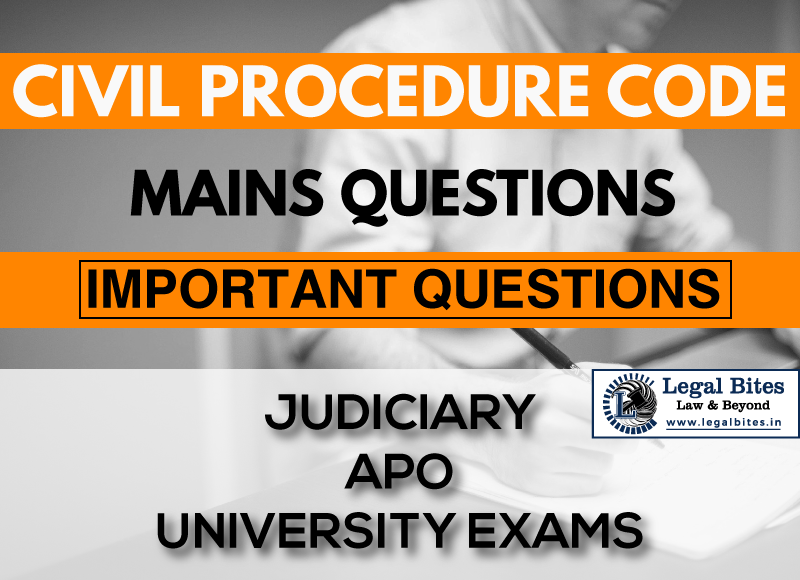Describe the Particulars of the plaint.
Find the answer to the mains question only on Legal Bites

Question: Describe the Particulars of the Plaint.Find the answer to the mains question only on Legal Bites. [Describe the Particulars of the Plaint.]AnswerPlaint is defined in Order VII of CPC. A plaint is a legal document that contains the written statement of the plaintiff’s claim. A plaint is the first step toward the initiation of a suit. It can be said to be a statement of claim, a document, by the presentation of which the suit is instituted. However, the expression “plaint” ...
Question: Describe the Particulars of the Plaint.
Find the answer to the mains question only on Legal Bites. [Describe the Particulars of the Plaint.]
Answer
Plaint is defined in Order VII of CPC. A plaint is a legal document that contains the written statement of the plaintiff’s claim. A plaint is the first step toward the initiation of a suit. It can be said to be a statement of claim, a document, by the presentation of which the suit is instituted. However, the expression “plaint” has not been defined in the code. It is a pleading of the plaintiff.
In plaint, the plaintiff should allege facts about his cause of action. A plaint that is presented to a civil court of appropriate jurisdiction contains everything, including facts to relief that the plaintiff expects to obtain.
Particulars of the Plaint
- The name of the particular court where the suit is brought; [R.1(a)];
- The name, place, and description of the plaintiff’s residence; [R.1(b)];
- The name, place, and description of the defendant’s residence; [R.1(c)];
- A statement of unsoundness of mind or minority in case the plaintiff or the defendant belongs to either of the categories; [R.1(d)];
- The facts that led to the cause of action and when it arose; [R.1(e)];
- That fact that points out to the jurisdiction of the court ; [R.1(f)];
- A statement of the value of the subject matter of the suit for the purpose of jurisdiction and court fees; [R.1(i)];
- The relief claimed by the plaintiff, simply or on the alternative; [R.1(g)];
- Where the plaintiff files a suit in a representative capacity the facts showing that the plaintiff has an actual existing interest in the subject matter and he has taken steps that may be necessary to enable him to file such a suit; [R. 4];
- Where the plaintiff has allowed a set-off or relinquished a portion of his claim, the amount so allowed or relinquished; [R.1(h)];
- Where the suit is for recovery of money, the precise amount claimed; [R 2]
- Where the suit is for accounts or mesne profits or for movables in the possession of the defendant or for debts which cannot be determined, the approximate amount or value thereof; [R. 2]
- Where the subject matter of the suit is immovable property description of the property sufficient to identify it, e.g. boundaries, survey numbers, etc; [R.3]
- The interest and liability of the defendant in the subject matter of the suit; [R. 5]
- Where the suit is time-barred, the ground upon which the exemption from the law of limitation is claimed; [R. 6 ]
Important Mains Questions Series for Judiciary, APO & University Exams
- CPC Mains Questions Series: Important Questions Part – I of X
- CPC Mains Questions Series: Important Questions Part – II of X
- CPC Mains Questions Series: Important Questions Part – III of X
- CPC Mains Questions Series: Important Questions Part – IV of X
- CPC Mains Questions Series: Important Questions Part – V of X
- CPC Mains Questions Series: Important Questions Part – VI of X
- CPC Mains Questions Series: Important Questions Part – VII of X
- CPC Mains Questions Series: Important Questions Part – VIII of X
- CPC Mains Questions Series: Important Questions Part – IX of X
- CPC Mains Questions Series: Important Questions Part – X of X

Mayank Shekhar
Mayank is an alumnus of the prestigious Faculty of Law, Delhi University. Under his leadership, Legal Bites has been researching and developing resources through blogging, educational resources, competitions, and seminars.
